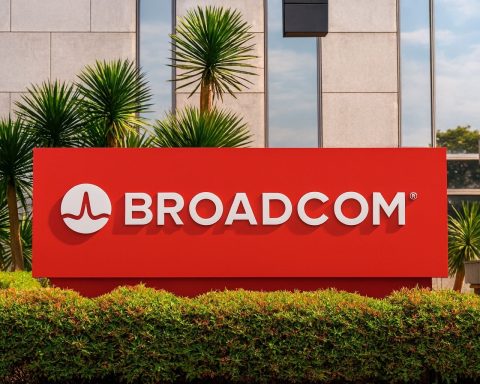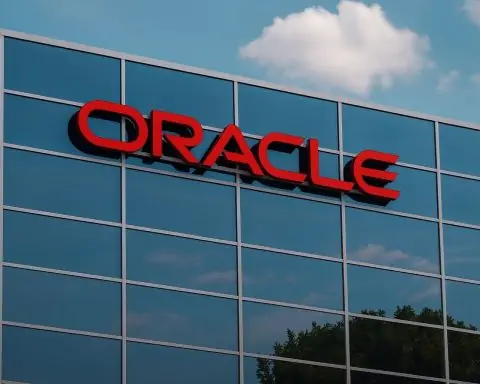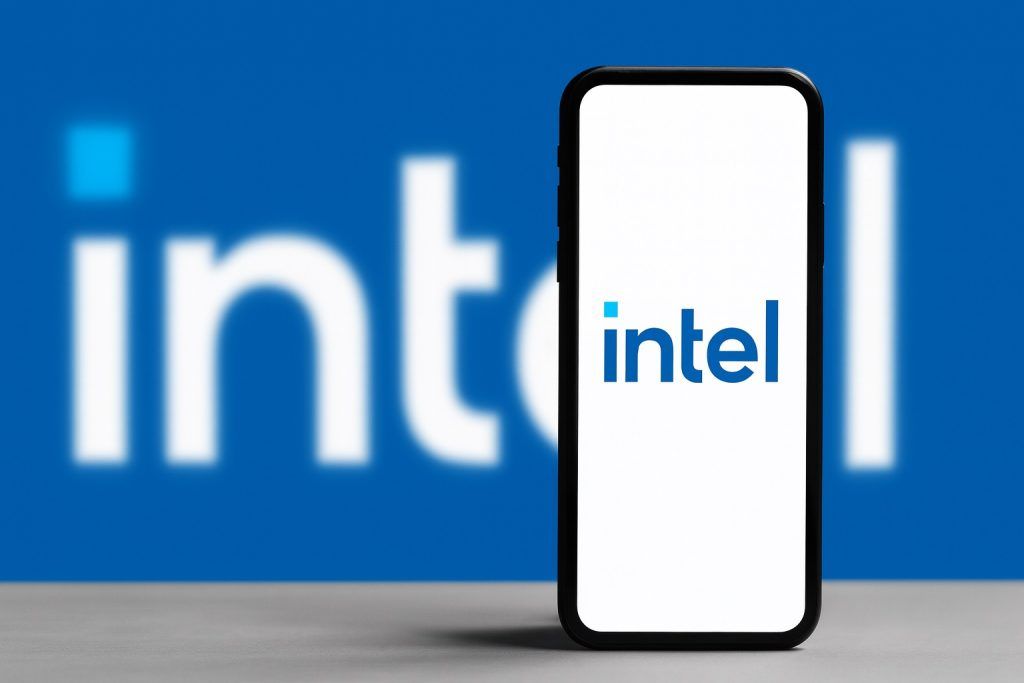- Massive 2025 Rally: SoFi Technologies (NASDAQ: SOFI) shares have surged roughly 230% this year, recently closing around $30 – an all-time high – after Q3 results [1]. The stock is up far more than broader market indexes and fintech peers, reflecting renewed investor enthusiasm.
- Record Q3 Results:Q3 2025 was a blowout quarter. Net revenue hit $962 million (∼+38% YoY) with net income of $139 million – both record highs [2]. Adjusted revenue ($950M) beat Wall Street’s ~$886M forecast, and adjusted EPS of $0.11 topped consensus (~$0.08) [3]. SoFi hiked its full-year profit outlook to $0.37/share (vs. $0.31 prior, analysts ~ $0.32) [4], and shares jumped ~3% on the news [5].
- Growth Drivers: SoFi’s one-stop digital finance platform is firing on all cylinders. Loan originations totaled a record $9.9 billion in Q3 (+57% YoY), as demand for personal, student, and home loans soared [6]. Fee-based revenues (from banking, investing, etc.) surged 50% year-over-year [7], while financial services revenue jumped 76% to $419.6 million [8]. Member count climbed ~35% to 12.6 million, and total products rose similarly to 18.6 million [9] – highlighting robust user growth fueling its ecosystem.
- Analyst Reactions Split: Wall Street remains divided on SoFi’s trajectory. Bulls like Mizuho (Buy, $31 target) tout its rapid growth and “strong rate-driven outlook” [10], and prominent investors (e.g. Cathie Wood’s ARK fund) call SoFi “a fast-growing business now proving its financial maturity” [11]. But skeptics warn the valuation looks stretched after the rally. Morgan Stanley rates it Underweight (fair value ~$18), cautioning that at ~50× forward earnings the stock has “a lot of good news” priced in [12]. Similarly, KBW tags SoFi Underperform (≈$18 target) on rich valuation concerns [13]. Overall, the consensus rating is Hold with an average price target in the low $20s – well below the current price [14]. (Notably, one of the most bullish calls, from Needham, just set a $36 target [15].)
- Fintech Frenzy & Sector Trends: SoFi’s surge comes amid a broader fintech revival. The fintech sector is “buzzing” after strong earnings from names like SoFi and PayPal, which unveiled a new AI partnership [16]. Cooling inflation has rekindled hopes of Federal Reserve rate cuts, boosting growth-focused finance stocks – SoFi shares even spiked ~2% on Oct. 24 after tame CPI data fueled dovish sentiment [17]. As a digital neobank, SoFi is also capitalizing on consumers’ shift away from traditional banks toward app-based financial services [18] [19].
Soaring Stock Performance in 2025
SoFi’s stock has been on a tear in 2025, skyrocketing about 230% year-to-date [20]. The share price recently hit the low $30s, marking a fresh all-time high (briefly touching $30.30 on Oct. 27) [21]. This meteoric rise has swelled SoFi’s market capitalization to roughly $36 billion [22]. By comparison, SoFi traded in the single digits late last year; the incredible 2025 rally reflects a dramatic turnaround in investor sentiment.
Several factors have fueled the climb. First, financial performance has improved markedly – SoFi moved into profitability this year, a milestone for the once-unprofitable fintech. The company’s evolution from a niche student-loan refi startup into a diversified digital bank has attracted a wider investor base. “The company has grown into one of the most prominent names in U.S. fintech,” Reuters notes, as SoFi offers everything from loans and savings accounts to stock investing in one app [23]. Its ascent has “mirrored the rise of younger consumers” favoring online platforms over traditional banks [24]. This demographic tailwind, combined with SoFi’s expanding product suite, has underpinned the stock’s outperformance.
The market’s risk appetite for fintech has also rebounded in 2025. As inflation showed signs of cooling and the Fed paused rate hikes, high-growth tech and finance stocks caught a bid. SoFi’s high beta (≈1.9) means it tends to swing more than the market [25] – amplifying gains during bullish stretches. Indeed, SoFi has consistently outpaced financial sector indices this year. Even a modest pullback in early October (amid broader market volatility) was short-lived, as an analyst upgrade on Oct. 20 sent SoFi jumping 8% intraday and propelled it to new highs [26]. By late October, SoFi was up over 3× since January, far outperforming most bank stocks in 2025 [27].
Blowout Q3 Earnings Fuel Confidence
SoFi’s latest earnings underscored the company’s momentum. Third-quarter 2025 results, released October 28, were emphatically strong across the board. Total net revenue hit $961.6 million, a 38% jump from a year ago [28]. This topped analyst expectations (around $885–$904 million) by a wide margin [29] [30]. Importantly, SoFi is now solidly profitable: Q3 generated $139 million in GAAP net income, a stark improvement from a net loss a year earlier [31]. Adjusted EBITDA nearly doubled year-on-year to $277 million [32], reflecting operating leverage as the business scales.
On a per-share basis, SoFi earned about $0.11 (adjusted) in Q3, beating the ~$0.08 EPS consensus [33]. Buoyed by the strong quarter, management raised its full-year earnings forecast – now projecting $0.37 in adjusted EPS for 2025, up from ~$0.31 prior [34]. That new guidance is above Wall Street’s estimate (~$0.32) [35], signaling SoFi’s confidence in continued growth through year-end.
“The health of our members is strong and our portfolio is in great shape,” SoFi CEO Anthony Noto told Reuters after the earnings, highlighting excellent credit performance in the quarter [36]. In a statement, Noto credited the results to the “strength of our innovation and the power of our one-stop shop strategy,” as SoFi added a record number of new customers and products [37]. With the company firing on all cylinders, he said “the opportunity before us is massive” and emphasized that SoFi is “investing aggressively” in areas like crypto, blockchain, and AI to continue its expansion [38].
Investors cheered the Q3 beat and bullish outlook. SoFi’s stock jumped about 3% in morning trading after the results came out [39], on top of a 4% pre-earnings rally the day before [40]. The stock closed Oct. 28 around $31 – up sharply from the low-$20s just a month prior. This positive reaction suggests the market sees SoFi’s “beat-and-raise” performance as validation of the company’s strategy [41]. Notably, Q3 marked SoFi’s second consecutive profitable quarter, reinforcing that its rapid revenue growth is now translating into the bottom line.
Rapid Growth Engines: Loans, Members & New Offerings
SoFi’s record quarter was driven by broad-based growth in its business. The company operates three segments – Lending, Financial Services, and Technology – and saw strong momentum in each:
- Lending boom: With student-loan payments restarting nationally, SoFi’s core lending business had a banner quarter. Total loan originations surged 57% year-on-year to $9.9 billion [42], the highest ever for SoFi. Personal loans remained the workhorse, but management noted student loan refinancing demand jumped now that federal loan moratoriums have ended [43]. In fact, SoFi’s student loan refi volumes were up roughly 35% in Q3 [44]. Home loans also contributed as SoFi expanded its mortgage offerings. Crucially, credit quality stayed “excellent” with net charge-offs improving despite the higher loan volumes [45] – a sign that SoFi’s largely prime customer base remains healthy.
- Fee income & new members: SoFi’s Financial Services segment (which includes deposit accounts, investment brokerage, credit cards, etc.) saw explosive 76% revenue growth, reaching $419.6 million in Q3 [46]. This was fueled by a 35% spike in SoFi’s member count to 12.6 million users [47], who are using more products than ever. SoFi’s “financial Super-App” strategy is paying off – the firm added 905,000 new members in Q3 alone [48], a record influx, and cross-selling drove 1.4 million new products (like new accounts or services) [49]. Nearly 19 million total products are now on the platform [50]. These users contributed to fee-based revenues jumping 50% year-over-year [51] through higher interchange fees, investment activity, and other non-interest income. SoFi’s banking arm also benefited from rising interest income on loans and its growing deposit base (attracted by above-average savings rates the company offers).
- Tech platform & innovation: SoFi’s Galileo and Technisys units (B2B technology services for fintech partners) delivered steady growth, helping diversify revenue. But beyond the numbers, SoFi made notable product moves in recent weeks. In October, the company launched commission-free options trading for retail investors on its app – enabling users to trade stock options with no fees [52]. SoFi also rolled out a new AI-driven ETF (ticker: AGIQ) focused on artificial intelligence trends [53]. These initiatives aim to boost user engagement and attract tech-savvy investors. Additionally, SoFi is forging into crypto and blockchain finance: Noto said crypto trading is on track to launch on SoFi’s platform this year, and the company is developing its own FDIC-insured stablecoin (tentatively “SoFi USD”) for the first half of 2026 [54]. Such innovations – alongside partnerships like SoFi’s Galileo joining Amazon’s AWS network to expand cloud payment services [55] – give SoFi future growth levers beyond traditional lending.
All told, SoFi’s revenue streams are more diversified than ever. In Q3, non-interest income made up ~43% of adjusted net revenue [56], as the firm’s newer financial services begin to meaningfully contribute. This diversification, combined with strong execution, yielded a “record quarter” on multiple fronts [57]: record revenue, record new customers, record products, and record profit.
Street View: Bulls vs. Bears on SoFi’s Prospects
After such a torrid run in the stock, what comes next? Here analysts and experts are split. Optimists argue SoFi is only beginning to realize its potential now that it has achieved profitability and scale. They point to the company’s 35–40% revenue growth (far above legacy banks), expanding margins, and opportunities in new markets (like investing and crypto). Mizuho recently reiterated a Buy rating and $31 price target, citing SoFi’s accelerating member growth and noting the company is thriving even in a high-rate environment [58]. Bulls also take comfort in SoFi’s improving operating leverage – as growth continues, profits could ramp up quickly. In fact, consensus forecasts predict SoFi’s earnings will roughly double next year (MarketBeat estimates EPS rising from ~$0.26 to $0.53) [59] [60], highlighting expectations for triple-digit percentage earnings growth.
Furthermore, high-profile growth investors have thrown their weight behind SoFi. Cathie Wood’s ARK Invest, for example, has been buying shares, expressing conviction in SoFi’s long-term disruptive potential [61]. One top investor recently praised SoFi as “a fast-growing business now proving its financial maturity” [62] after years of losses. Supporters believe SoFi’s vertically integrated model – owning a bank charter, a brokerage, and a tech platform – gives it a “sustainable competitive advantage” and ability to cross-sell products that rivals can’t easily match.
Skeptics, however, urge caution. With the stock up 3× in a year, SoFi’s valuation has ballooned. At about 50 times forward earnings, the stock is priced for perfection [63]. Morgan Stanley currently rates SoFi Underweight, arguing the valuation already bakes in a lot of optimism [64]. The bank’s analysts peg SoFi’s fair value around $18 – roughly 40% below the current price – and warn that any growth hiccup or economic downturn could hit the richly valued stock hard [65]. Other bears note that SoFi’s price-to-book and price-to-sales multiples are high relative to established banks, and that as a lender, SoFi could face rising credit losses if consumers deteriorate (though there’s no sign of that yet). Keefe, Bruyette & Woods (KBW) likewise has an Underperform on SOFI, with a price target near $18, citing the risk that exuberant growth expectations may not be fully met [66].
For now, the average Wall Street stance is neutral. Of 15–20 analysts covering SoFi, most rate it Hold, a few say Buy, and a few say Sell. The average 12-month price target is about $22–$24 [67] [68], well under the current ~$30 level – meaning analysts generally see the stock as ahead of fundamentals after its 2025 run-up. That said, price targets have been rising. Just this week (post-earnings), Needham reaffirmed a Buy and boosted its target to $36 [69], implying belief that SoFi can climb higher. At the same time, Barclays recently upped its target from $18 to $21 (yet still rated SoFi “Hold”) as the company’s results consistently beat expectations [70]. This dispersion in targets – from ~$12 on the low end to the mid-$30s at the high end [71] – shows the wide range of opinions on SoFi’s outlook. Key debate points include how quickly SoFi can grow earnings to justify its valuation, and whether its customer growth will continue at the same torrid pace once pandemic-era tailwinds (like student-loan refi demand) normalize.
Broader Market & Fintech Context
SoFi’s stellar performance isn’t happening in isolation – it comes amid a resurgence in fintech stocks broadly. After a rough 2022–2023, fintechs have roared back this year, helped by a stabilizing economy and industry-specific catalysts. PayPal (PYPL), another fintech heavyweight, also reported better-than-expected earnings this week and announced a high-profile partnership with OpenAI, which sent its stock higher [72] [73]. Block (SQ) and Robinhood (HOOD) have likewise seen improved sentiment as they streamline operations.
Analysts note that interest rates, a key macro factor, are potentially at a turning point. While the Fed’s rapid rate hikes in 2022–2023 created headwinds for consumer lenders, the current cooling inflation trend has markets betting that rate hikes are done – and cuts could begin in 2024. Such a scenario would benefit growth-oriented finance firms like SoFi, which would enjoy lower funding costs and likely increased loan demand. Indeed, signs of easing inflation in October “rekindled rate-cut hopes” and gave fintech stocks a boost [74]. On Oct. 24, when a benign CPI report hit, SoFi’s stock jumped ~2% intraday [75]. “The fintech sector is buzzing,” observed Schaeffer’s Investment Research, with investors rotating back into the space as macro pressures ease [76].
Competitive landscape: SoFi operates at the intersection of banking and technology, putting it in competition with both legacy banks and fintech peers. Traditional banks have been upping their digital game, but SoFi – with no physical branches and a tech-centric model – often appeals more to millennials and Gen Z users. Its advantage was further solidified by obtaining a national bank charter in 2022, allowing SoFi to accept deposits and fund loans more cheaply. This has helped SoFi offer checking accounts with attractive yields (over 4% APY), drawing in $ deposits and facilitating growth [77]. Meanwhile, among fintech peers, neobanks like Chime and online lenders like LendingClub are also vying for young customers. But SoFi’s strategy of offering a full suite of services (banking, investing, lending, credit cards, insurance, etc.) under one roof is relatively unique. This “financial services productivity loop” – cross-selling multiple products to each member – has led to increasing revenue per user and strong customer retention [78]. If this trend continues, SoFi could strengthen its position as a leading consumer finance platform for the digital generation.
Regulatory developments are another factor to watch. Thus far, SoFi has navigated the regulatory environment well – even crypto exposure (SoFi lets users buy crypto within its app) has been managed under oversight. In fact, SoFi’s bank charter gives it a “cleaner regulatory footing” than many fintech rivals that rely on third-party bank partners [79]. One potential game-changer on the horizon: student loan policy. There are rumors that Congress or the U.S. Treasury might explore selling off portions of the $1.6 trillion federal student loan portfolio to private lenders [80]. Such a move (though speculative at this stage) would represent a massive market opportunity for SoFi, which is a top player in student-loan refinancing. Even the prospect of a partial privatization of student loans has “fueled bullish sentiment” among SoFi investors [81], given the firm’s roots in that business. While no decisions are made yet, it’s an upside scenario that could further lift SoFi’s long-term growth potential.
Outlook: High Hopes with Execution Key
Looking ahead, SoFi enters the end of 2025 with significant momentum – and high expectations. The company’s own guidance implies full-year adjusted revenues around $3.5 billion and a strong profit ramp-up in Q4 [82]. Executives believe the platform effects are kicking in: as more members join and use multiple SoFi products, the economics improve and marketing efficiency rises. CEO Anthony Noto remains emphatic about continuing to invest in innovation and growth, stating that SoFi is “executing from a position of unparalleled strength” and will “accelerate innovation in crypto, blockchain, and AI” to serve more members [83]. The firm’s expansion into new offerings (like options trading, ETFs, international transfers via crypto networks, etc.) could provide additional revenue streams in 2026 and beyond [84] [85].
In the short term, all eyes will be on SoFi’s Q4 2025 results and 2026 outlook, set to be reported in a few months. Can SoFi maintain ~30%+ growth rates as its revenue base gets larger? Analysts on average forecast continued robust growth, with consensus calling for over 30% revenue growth in 2026 and further margin improvement [86] [87]. Many expect SoFi’s earnings to roughly double year-over-year in the next report, given the low base and rising profitability [88]. The company’s ability to sustain its torrid user growth will be critical to hitting those targets. Competition and credit trends will be key watch areas: if fintech competition forces higher customer acquisition costs, or if consumer credit deteriorates due to economic stress, it could slow SoFi’s trajectory.
For now, however, SoFi is riding high on a wave of positive factors – record financial performance, bullish consumer trends, and investor fervor for fintech. The stock’s 230% rally in 2025 stands as a testament to the market’s belief in SoFi’s vision. After such a run, volatility is to be expected, but many stakeholders see this as SoFi’s break-out moment. As 24/7 Wall St. put it, SoFi’s Q3 results “justified” the stock’s big run-up into earnings [89] [90]. Going forward, if SoFi continues to execute and deliver high growth (and perhaps an occasional upside surprise), it could further validate the bullish case. Yet if the company stumbles or macro conditions shift, its rich valuation could face a reality check. In sum, SoFi has transformed into a formidable fintech force in 2025, with rapid growth and improving profits – now it must prove it can live up to the hype in the years ahead.
Sources: SoFi Investor Relations; Reuters; TS²/TechStock² [91] [92] [93] [94]; Alpha Spread [95]; Schaeffer’s Investment Research [96]; GuruFocus/Guru Picks [97]; Benzinga Analyst Ratings [98]; MarketBeat [99]; PaymentExpert [100] [101].
References
1. ts2.tech, 2. www.alphaspread.com, 3. www.reuters.com, 4. www.reuters.com, 5. www.reuters.com, 6. www.reuters.com, 7. www.reuters.com, 8. www.reuters.com, 9. investors.sofi.com, 10. ts2.tech, 11. ts2.tech, 12. ts2.tech, 13. ts2.tech, 14. ts2.tech, 15. www.benzinga.com, 16. www.schaeffersresearch.com, 17. ts2.tech, 18. www.reuters.com, 19. www.reuters.com, 20. ts2.tech, 21. ts2.tech, 22. www.reuters.com, 23. www.reuters.com, 24. www.reuters.com, 25. ts2.tech, 26. ts2.tech, 27. ts2.tech, 28. www.alphaspread.com, 29. www.reuters.com, 30. ts2.tech, 31. www.alphaspread.com, 32. investors.sofi.com, 33. www.reuters.com, 34. www.reuters.com, 35. www.reuters.com, 36. www.reuters.com, 37. investors.sofi.com, 38. investors.sofi.com, 39. www.reuters.com, 40. www.alphaspread.com, 41. ts2.tech, 42. www.reuters.com, 43. ts2.tech, 44. ts2.tech, 45. www.reuters.com, 46. www.reuters.com, 47. investors.sofi.com, 48. investors.sofi.com, 49. investors.sofi.com, 50. investors.sofi.com, 51. www.reuters.com, 52. ts2.tech, 53. ts2.tech, 54. www.reuters.com, 55. ts2.tech, 56. investors.sofi.com, 57. www.alphaspread.com, 58. ts2.tech, 59. paymentexpert.com, 60. www.gate.com, 61. ts2.tech, 62. ts2.tech, 63. ts2.tech, 64. ts2.tech, 65. ts2.tech, 66. ts2.tech, 67. www.zacks.com, 68. ts2.tech, 69. www.benzinga.com, 70. www.marketbeat.com, 71. www.zacks.com, 72. www.schaeffersresearch.com, 73. www.schaeffersresearch.com, 74. ts2.tech, 75. ts2.tech, 76. www.schaeffersresearch.com, 77. paymentexpert.com, 78. paymentexpert.com, 79. paymentexpert.com, 80. ts2.tech, 81. ts2.tech, 82. www.reuters.com, 83. investors.sofi.com, 84. ts2.tech, 85. ts2.tech, 86. ts2.tech, 87. paymentexpert.com, 88. paymentexpert.com, 89. www.alphaspread.com, 90. www.alphaspread.com, 91. ts2.tech, 92. www.reuters.com, 93. www.reuters.com, 94. www.reuters.com, 95. www.alphaspread.com, 96. www.schaeffersresearch.com, 97. www.gurufocus.com, 98. www.benzinga.com, 99. paymentexpert.com, 100. paymentexpert.com, 101. paymentexpert.com







